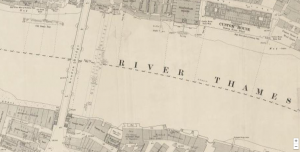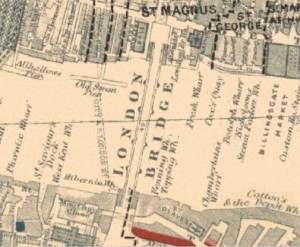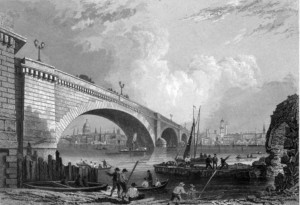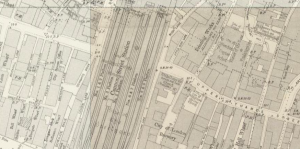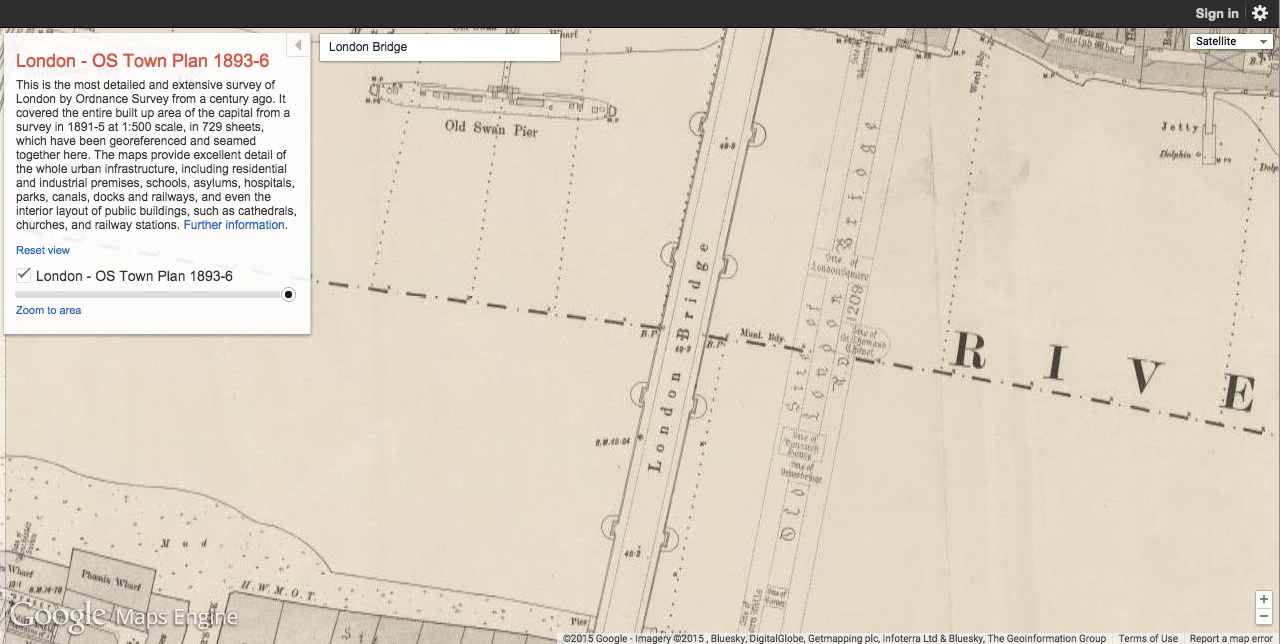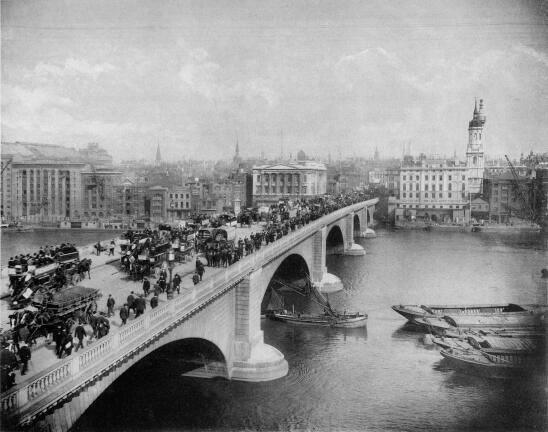Class Blog
This is the category necessary for student blog posts to appear in the correct section of the website.
Scandal in Bohemia Group Map : Shianne, Laura, Marriah
Scandal in Bohemia Mapbox Project (Daniela Velez, Katie Vyas, Dea Barbieri )
Scandal in Bohemia Project By Daniela Velez, Katie Vyas, Dea Barbieri (Edgware Road Group)
If having trouble viewing, click the here.
The Man with the Twisted Lip and London Bridge

The London Bridge, the first stone bridge to be built in England across the Thames from the city of London to Southwark. The bridge has been rebuilt numerous times over the years it has been around (Victorian Web).
Although many versions of this bridge have been built, the bridge designed by John Rennie and built by his sons John and George Rennie would have been the one that was mentioned in Sir Authur Conan Doyle’s work (Victorian Web).
In the particular story, The Man with the Twisted Lip , we see the London Bridge when Watson is in search for one of his patients in an Opium Den. When Victorians read this story they would have known that around the London Bridge, Opium Dens would be present. Opium was always associated with people of the east (from Asia) and sailors. Surrounding London Bridge were many docks. Opium Dens popped up around these docks because of the association of opium and sailors/Asians. Doyle makes it ironic in the fact that the man out of his mind in the opium den is an “upstanding” patient of Dr.Watson.
Opium dens were perfectly legal at this time however “good” men were known to get lost in them. These men changed as soon as they stepped into the den. For instance Mr. Neville St. Claire who has “disappeared” has actually changed his whole persona into a beggar. The reader can then see the London Bridge as a turning point. Once the men have crossed that bridge and made their way to the dens, they are changed themselves.
Another inference that could be made is the bridge is a symbol. The bridge, as said before, has changed numerous times.From tinder to stone to being moved a few yards.. Although Victorians may have not seen the recent changes, they would have known of a few that have happened over time and may have witnessed one themselves. The characters are crossing a bridge that has changed numerous, to be “changed” themselves.
Sources
http://www.victorianweb.org/victorian/art/architecture/feist/30.html
http://www.victorianweb.org/graphics/fearnside/47.html
http://www2.warwick.ac.uk/fac/arts/english/currentstudents/undergraduate/modules/fulllist/special/endsandbeginnings/twistedlip.pdf
http://www.britannica.com/topic/Old-London-Bridge
Cannon Street
Cannon Street does not play a large role in the “The Man with The Twisted Lip” except for serving as the center of Neville St. Clair’s ventures. The train station is how he gets to and from opium. Before he was a wealthy, employed, respected Englishman, he would travel into town and return via Cannon Street at 5.14 each day due to his interest in companies in that area. This establishes St. Clair as an honest hardworking London citizen who spent long hours in town looking for work until he attained his objectives. In contrast to Mr. St. Clair’s 37 year old self, who spends time near Fresno Street and Upper Swandam Lane at opium dens, he was driven as a young man. Ironically, St. Clair establishes himself in the neighborhood near Cannon Street and this is also the neighborhood of his downfall.
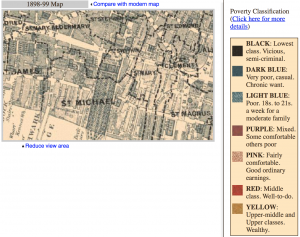
According to the Charles Booth Online Archive the area surrounding Cannon Street was chronically poor and struggling.Old Bailey Online records that the majority of crimes were theft, peace disturbance, and deception. Deception is particularly relevant to “The Man with the Twisted Lip” because in the same way that St. Clair adjusted to the business district as a young man is the same way in which he disguised himself in the crowds of East London and opium dens except this instance was deceitful and harmful.
Questions to Ask About Locations
Are you unsure about how to analyze the significance of locations in a story? Try answering these questions:
- Are there many or few place names in the story?
- Are most of the locations real or fictional? Is there a pattern?
- Is the description of the area realistic or has it been fictionalized? Why?
- Does each location have a similar number of pages dedicated to it?
- What is discussed at each location? Is there a pattern to what is discussed where?
- Are there connections between a location and the theme of the story at that location?
Let’s Journey Down London Road
London Road was briefly mentioned in “The Man With the Twisted Lip” just before Holmes and Watson discovered St.Clair’s/Boone’s duplicitous nature. In the story, Holmes and Watson are leaving London Road, possibly foreshadowing St. Clair’s means for sustaining and attaining his wealth.
Important themes present within “The Man With the Twisted Lip” are the value that people place in appearances and the importance that appearance holds when people consider being presented to society. While not ideal and duplicitous, St. Clair’s dual identity as Boone allows him to indulge the rich while he slowly becomes one of them.
Neville St. Clair could be seen as a twisted version Batman because, like Bruce Wayne, he uses his dual identity to become a different person.
The distance and use of the word ‘dashing’ could foreshadow St. Clair returning to his humble beginnings and fall from grace (but not wealth).
This map shows that proximity to London Road greatly decided a person’s socioeconomic status, as the well-to-do were the closest to the street. As a person’s distance from the street grew, however, the surrounding socioeconomic statuses varied. Possibly due to the Road’s wealth, the few crimes that took place on it were theft.
Cannon Street Station
In Sir Arthur Conan Doyle’s story “The Man with the Twisted Lip,” Cannon Street Station in London gets a quick mention by Sherlock Holmes. In the story, Holmes mentions that Neville St. Clair had a routine of “returning by the 5.14 from Cannon Street every night” (Doyle 133). Cannon Street Station is a real train stop, which still operates in London today. The station opened in 1866 and was a widely used station in London at the time. There was also a hotel at the station where “arrangements were made for reception of about 20,000,000 passengers yearly” (Thornbury). At the time “The Man with the Twisted Lip” was published, the station was just under thirty years old. Despite the fact that St. Clair is understood to be relatively well off, according to the Charles Booth Online Archive, much of the area nearby the station lived in poverty. Also, St. Clair may travel through Cannon Street, because it is a poorer area, making his charade as a beggar more believable. He could very easily blend in with those more in need than he. According to the Old Bailey online, most crimes that happened on Cannon Street were some form of robbery or burglary, although there are occasional cases of murder, but most cases that took place in the station had to do with some form of theft. This is a strong connection to St. Clair’s occupation of the opium den, as opium dens were often times connected with crime. The cases of theft may make Cannon Street a metaphor for the fact that St. Clair poses as a beggar. In a sense, he is stealing from those more in need than he. This plays into the themes of deception and poverty, which are very common themes in Victorian literature including the stories of Holmes.
Works Cited
Booth, Charles. “Booth Poverty Map (Charles Booth Online Archive).” Booth Poverty Map (Charles Booth Online Archive). LSE Library, n.d. Web. 19 Oct. 2015.
Doyle, Arthur Conan. “The Man with the Twisted Lip.” The Adventures of Sherlock Holmes. London: Penguin, 1995. 133. Print.
“The Proceedings of the Old Bailey.” Old Bailey Online. N.p., n.d. Web. 19 Oct. 2015.
Thornbury, Walter. ‘Cannon Street.’ Old and New London: Volume 1. London: Cassell, Petter & Galpin, 1878. 544-550. British History Online. Web. 14 October 2015. http://www.british-history.ac.uk/old-new-london/vol1/pp544-550.
London Bridge
London Bridge was designed by John Rennie and completed in 1831. The construction of the bridge cost about 2 million pounds, spanning 928 feet long and 54 feet wide. The bridge accumulated a lot of foot traffic and public transportation such as omnibuses. According to The Victorian Web, it was estimated that 22,000 vehicles and 110,000 pedestrians crosses London Bridge daily. According to Old Bailey Online, there are countless documentations of crime on and around London Bridge, the most common crime being theft. With all of these people moving around in one 54-foot wide place it makes sense that one of the biggest crimes that occurred on the bridge was theft. This is theft of all kinds, the most common being pickpocketing, but it expanded to larceny, highway robbery, animal theft, and so on. The bridge was flanked by wharves, which are just places for boats to dock and unload their shipments, on either side. In Conan Doyle’s story, “Twisted Lip”, these wharves are the places that hide the opium den, “vile alley lurking the high wharves which line the north side of the river to the east of London Bridge” (128). The bridge gives the reader the geographic location of the opium den, on the east side of the bridge (east being where the poorer people live). “Between a slop-shop and a gin-shop, approached by a steep flight of steps leading down to a black gap like the mouth of a cave, I found the den of which I was in search” (128), a slop-shop is a shop where cheap, ready made clothes are sold and a gin shop is a liquor store. The reader already knows that this is a poor area. The image of “the mouth of a cave” gives the story a dark, grimy tone, and because it wasn’t hard for John to find, it makes me think that this is common knowledge, that if one is looking for an opium den, all you have to do is go to London Bridge.
Bow Street Police Court
Bow Street seems to have been home to a mixed population of middle and lower class families, the middle class evidenced by the purple and red, with the lower class being the duller cool colors.
Bow Street serves as a through-route from Waterloo Bridge to St. Giles’s and Bloomsbury, and is known for the nature of public buildings around it. Bow Street’s association with the law dates back to 1740 when a justice for Middlesex, Thomas De Veil, transferred his office into No.4 Bow Street, which became the court-house of Bow Street magistrates. Across the street from the court-house, the first police station was opened on the street was back in 1832 until it was removed in 1880. The establishment of the police station did not affect the magistrates’ office, and stayed in its location until 1880, whereupon the police were removed to the present station and Nos.33-34 (the police court) was converted into a market warehouse, and then eventually demolished.
Bow Street is mentioned and becomes a crucial setting point in Arthur Conan Doyle’s “The Man With the Twisted Lip”, a short Sherlock Holmes piece where Holmes and Watson investigate the disappearance of Neville St. Clair. After getting an idea of what might’ve happened to Neville, Holmes and Watson travel to the Bow Street Police Court where Neville, disguised as Hugh Boone, a beggar, is being kept in a cell. Holmes takes out a sponge and washes down Boone until the man is revealed to be Neville, who faked his own death out of shame that his wife had caught him while he was leading his double life – one as a respectable man and the other as a beggar. It is the setting of the climax.

